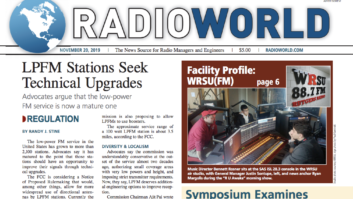
The low-power FM service in the United States has grown to more than 2,100 stations. Advocates say it has matured to the point that those stations should have an opportunity to improve their signals through technical upgrades.
The FCC is considering a Notice of Proposed Rulemaking that would, among other things, allow for more widespread use of directional antennas by LPFM stations. Currently the rules allow LPFMs to use directional antennas under special circumstances, including as part of a second adjacent waiver request or for LPFMs licensed for public safety purposes. The commission is also proposing to allow LPFMs to use boosters.
The approximate service range of a 100 watt LPFM station is about 3.5 miles, according to the FCC.
DIVERSITY & LOCALISM
Advocates say the commission was understandably conservative at the outset of the service almost two decades ago, authorizing small coverage areas with very low powers and height, and imposing strict transmitter requirements. Now, they say, LPFM deserves additional engineering options to improve reception.
Commission Chairman Ajit Pai wrote in a blog post this year: “When the commission launched the service in 2000, it designed LPFM requirements to be simple. The purpose was to make it easier for non-profit organizations with limited engineering expertise and small budgets to readily apply for, construct and operate stations service highly localized areas.”
Pai said the NPRM includes changes to increase flexibility while maintaining interference protection and the core LPFM values of diversity and localism.
The proposed rules would not be “a carte blanche for all LPFMs” to use directional antennas, said Michi Bradley, founder of REC Networks and an LPFM advocate who has pushed for rule changes.
Bradley said the main beneficiaries of the change would be a handful of LPFM stations near the Mexican border. Currently, stations within the Mexican border strip zone, within 125 kilometers, are limited to 50 watts ERP non-directional, Bradley said.
[Read more stories from the Nov. 20 issue of Radio World]
“The proposal would add a third category to allow LPFM stations to use DAs to limit power to 50 watts or less along radials that are within 125 km of the border and to allow the full 100 watts in directions away from Mexico,” Bradley said.
Another aspect of the proposed directional antenna changes is to permit, in certain cases, the use of composite directional antennas, as opposed to off-the-shelf models.
“This would give LPFM stations more flexibility to use antennas, such as the Nicom BKG-77, which are not listed in the FCC’s standard pattern list, as well as use multiple skewed antennas in order to maximize coverage while still protecting second adjacents or meeting international agreements.”
The FCC in its NPRM stated that it doesn’t think the use of DAs will be widespread: “We believe that directional antennas, whether off-the-shelf or custom models, will not be used widely in the LPFM service due to their higher cost and limited necessity. Nevertheless, the use of such antennas could, if properly engineered, provide significant flexibility to LPFM licensees subject to international agreements and to those that must relocate in areas with few available transmitter sites.”
The FCC is also contemplating a new definition for LPFM minor changes to include those that involve overlapping 60 dBu contours of the station’s existing and proposed facilities or a move of 5.6 km or less.
In addition, the proposal would allow LPFM stations to retransmit their signals over FM booster stations without a waiver in order to fill in terrain-associated gaps in service. REC believes very few LPFM stations would benefit from having FM boosters but that in some cases it may help fill in certain gaps in challenged coverage areas.
EXPERT ASSISTANCE
A Radio World review of comments filed through early November showed many commenters urging the FCC to adopt the technical upgrades.
Steven White, director of Triangle Access Broadcasting, Inc., said the FCC’s original goal of installing simple technical rules made sense under the circumstances.
“What became apparent was that, while the LPFM rules are comparatively simple, expert assistance was still required for many organizations that just don’t happen to have the right balance of people within themselves,” he wrote.
“If technical services are required anyway, then it is only proper to make the fullest use of those services and maximize the use of spectrum achieved with directional antennas.”
Veteran broadcast engineer Dana Puopolo wrote, “I support this proposal because it is well past time the commission stop treating low-power FM stations as second-class citizens. No other class of full-power FM station, translator or booster has the amount of technical restrictions as low-power FM stations do.
“For example, no other FM facility is restricted to such a small operating power, use of directional antennas, certification requirements for transmitters, use of an arbitrary 12 kilometer buffer and other restrictions as low-power FM stations are. The low-power FM service has become a mature service. It should be allowed the same rights (and responsibilities) as any other FM service.”
[NJBA: FCC Must Protect Full-Power Stations]
The Inge Davidson Foundation, licensee of WZML(LP) Bryn Mawr, Pa., wrote in support.
“For far too long, low-power FM stations have been at the bottom of the pecking order. No other class of full-power FM station, translator or booster has as many restrictions as low-power FM stations do,” said Linda Davidson, chairwoman of the foundation.
Mike Starling, president and GM of Cambridge Community Radio and WHCP(LP) in Cambridge, Md., expressed support for the “common-sense LPFM technical improvements outlined in MB docket No. 19-193.” Starling is a former director of technical operations at NPR.
VOICING CONCERNS
Other commenters, including full-power broadcasters, expressed concern about increased crowding in the FM band.
Representatives of Entercom Communications met with Chairman Pai recently and said that “certain modifications to the LPFM technical rules proposed in the Notice of Proposed Rulemaking … could bring increased congestion to the FM dial leading to interference to full-power stations,” according to a public filing.
The New Jersey Broadcasters Association reminded the commission of the need to “adhere to the obligations of secondary broadcast services” as it proceeds.
“Specifically, the obligation that secondary services not interfere with full-power radio broadcast stations,” the NJBA wrote. “In addition, the need for further expansion and competition from LPFM services is dubious at best — given that the radio broadcasting industry has already been subjected to increased competition from the recently-enacted FM translator rule changes, digital media, satellite radio, podcasts, internet and other media sources.”
The National Association of Broadcasters told the FCC, “NAB is concerned that the proposal to allow LPFM licensees expanded use of directional antennas could cause interference to full-service FM stations. We further object to the commission’s proposal to grant a blanket authorization to LPFM operators to use boosters,” the association wrote.
[Buffer Compromise Would Boost FM Class C4]
In addition, NAB supported the commission’s rejection of proposals to allow LPFM stations to increase power above 100 watts, which was suggested in REC Networks’ petition.
REC Networks has asked the FCC to reconsider 250-watt stations (LP-250). Under its proposal, Bradley said, LP-250 would only be available as an upgrade to already licensed LP-100 stations and be considered a minor change. In addition, any LPFM station proposing LP-250, FM translator relief or LPFM-to-LPFM short-spacing would be subject to an interference remediation rule similar to the one recently adopted by the FCC for FM translators.
“REC’s LP-250 proposal has been refined for many years, taking into consideration the input of NAB, EMF [Educational Media Foundation] and other opponents, and is statutorily sound,” Bradley contended.
Numerous LPFM broadcasters, filing comments on the current petition, also brought up a desire for LP-250 to better serve local communities.
[Is There an Afterlife for “Franken” FMs?]
Sharon Scott, president of WXOX(LP), a volunteer community radio station on 97.1 MHz in Louisville, Ken., commented on her support for the boost to 250 watts.
“While reviewing LPFM rules, we hope you will consider increasing our maximum allotted power from 100 watts to 250 watts of effective radiated power at 100 feet height above average terrain. This modest increase would greatly improve our ability to deliver the diverse voices of our community to those whom it matters the most,” Scott wrote.
Park Public Radio, which holds the license for KPPS(LP) in St. Louis Park, Minn., wrote, “Proposed rules do not substantially help the needs of incumbent LPFM broadcasters, and further reforms are necessary to address the unfavorable rules that LPFM operators face versus FM translator operators.” KPPS’ Jeff Sibert said he believes the commission should reconsider its tentative rejection of an LP-250 service.
Comment on this or any story. Email [email protected] with “Letter to the Editor” in the subject field.






